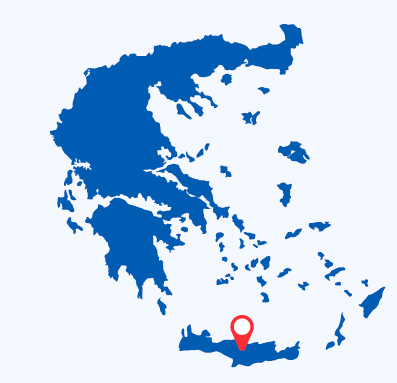Crete is the largest and most well-known island in the world and we are not taking a risk by calling it such! It is located in the southernmost part of Europe, very close to the coasts of Africa, so much so that on particularly clear days you can see the coasts of Libya and Egypt, where for many months the sun always shines and the temperatures are mild.
Describing Crete in a few lines is very difficult, it is immense and has so many things to talk about that it would never end. Let's say first of all that it is part of the Greek nation but that it differs from the other islands in many aspects, it is a world unto itself with traditions, habits and customs that can only be found here and this is also the beauty of it.
With an extension of three hundred square kilometers it is a continuous change of landscape, in Crete there are beaches that are in no way envious of the more famous tropical ones, ancient villages with a historical weight of universal importance, archaeological sites unique in the world, deep gorges, canyons, fertile plains, hidden coves, expanses of centuries-old olive trees, super modern towns, traditions and customs that have not changed over the centuries, what more could you ask for?
History of Crete
The history of Crete is perhaps one of the most complete and well-known which has definitely influenced the entire island culturally. We start with the Minoan civilization born in 2700 BC, the most remembered with its legendary King Minos and the most splendid period of Crete which, in addition to having a great commercial importance, contributed to increasing its magnificence with stupendous palaces and sculptures such as the legendary Palace of Knossos, the palace of Phaistos or the palace of Zakros. We then move on to the Doric and Hellenistic periods where the Cretans offered strong resistance to the invasion but were unable to maintain it, falling into the hands of the Kings of Argos and the King of Sparta who divided the territory between them. In the Hellenistic era they were servants of Alexander the Great but upon his death internal discord began with the conclusion of the division into city leagues Knossos, Gortyna, Phaistos and the League of the Mountains. Then the Romans arrived and, having failed in the first attempt with Mark Antony on Philip V of Macedonia, they took control of Crete in 80 BC, thus becoming a province of the Roman Empire under Diocletian who established Gortina as the capital in place of Cyrene in Libya. The Byzantine era which came after the Roman domination which in the meantime evangelised the island and legend attributes the credit to Saint Paul who landed in Crete after a shipwreck, gave splendid monasteries such as that of Arkadi, Toplu as well as all the art and architecture still present today. Could the Venetians have been missing? Of course not! In the 10th century, attracted by the favorable geographical position, they purchased Crete for 1000 silver marks, thus changing its history forever. Heraklion becomes the economic capital while Rethymno and Chania are transformed into fortresses but despite the economic and social improvement, many rebels organize popular uprisings. In the 14th century, the Orthodox church regained its powers making it grow both artistically and scientifically. And here we are at one of the ugliest and bloodiest chapters of Crete, the Ottoman rule. In 1645 Yussut Pasha occupied Chania with an army of 60,000 men. The Turkish siege lasted for 21 years and is recognized as the most important Venetian resistance like that of Famagusta in Cyprus. They were not happy years, Christians were perpetually persecuted and numerous churches were transformed into mosques. Despite everything, the Cretans opposed the conversion, thus managing to declare themselves independent in 1840 but paying a very high price in human lives. Finally in 1898, after difficult years marked by the loss of many people, Crete became an independent state, but always under the Sultan and the great European powers. The Cretans were not happy with this new idea so much so that they rose up with the Ieriso Revolution in 1905. However, everything was resolved in 1913 with the father of the Greek constitution Eleftherios Venizelos when Greece was finally free again. It therefore ends with the Second World War when the Germans occupy Crete but this time too the free spirit of the Cretans opposes it and after four years of German domination the island definitively conquers its independence under the Greek flag but maintaining a certain autonomy and above all respect for their traditions.
Speaking of the island itself, remember to go for a tour of the beautiful and well-kept Chania, also called the Cretan Venice with the ancient pastel-colored houses that line the seafront. A very lively city where you can sit at a café and let the time pass peacefully, or take a tour inside visiting the Municipal Market rather than the Mosque and the beautiful neighborhoods of Tobakaria, Topanas and Spantzia.
Also on the north-west side of Crete there are the most beautiful beaches that you must see at least once in your life. The beach of Elafonissis, the beach of Falassarna and the scenic Balos Lagoon just to name a few with coasts of soft and very white sand bathed by a sea that will leave you breathless.
The central part of the island, however, is characterized by mountains. If you love trekking, the Samaria Gorge is a unique and incredible spectacle of nature. 16 kilometers long with its caves where mythology says that in one of them Zeus was raised by the Nymphs. Or again for lovers of walking and discovery, the Lefka mountains which are home to the second longest canyon in all of Europe.
In the south west, however, you can breathe a completely different atmosphere, here there is the real Crete, the free-range and hard-core Crete. Here there is a different type of tourism, only those who love nature and archaeological sites and have no particular interest in nightlife come to these parts. How to miss the wonderful beach of Preveli and its Monastery, or spend a couple of days in the mythical town of Matala and still get to Loutro and then reach many hidden places on foot through an incredible landscape.
In the north-eastern part, however, we find the capital Heraklion, a city full of life and typically touristy where every year in the summer it is overrun by people from all over the world. Still on the coast, you come across Hersonissos and Malia, two perfect locations for those who love to spend the night but don't want to give up the sea, to then continue towards Agios Nikolaos which, when seen, reminds us a bit of our Venice with its center of stone alleys and houses traditional all around Lake Voulismeni which passes between the settlement and then flows into the sea.

The best facilities of Creta
Selected hotels and apartments that you can book with us
Why book a holiday in Creta with us?
- For us, every person is unique and consequently so is their holiday.
- Every quote you request is personalized and tailor-made
- We take care of everything, including guaranteed 24-hour assistance
